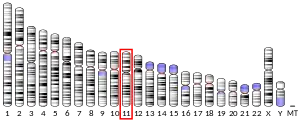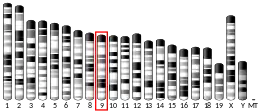CCDC82
Coiled-Coil Domain Containing protein 82 (CCDC82) is a protein that in humans, is encoded for by the gene of the same name, CCDC82. The CCDC82 gene is expressed in nearly all of human tissues at somewhat low rates. As of today, there are no patents involving CCDC82 and the function remains unknown.
| CCDC82 | |||||||||||||||||||||||||
|---|---|---|---|---|---|---|---|---|---|---|---|---|---|---|---|---|---|---|---|---|---|---|---|---|---|
| Identifiers | |||||||||||||||||||||||||
| Aliases | CCDC82, HSPC048, coiled-coil domain containing 82 | ||||||||||||||||||||||||
| External IDs | MGI: 1913646 HomoloGene: 11678 GeneCards: CCDC82 | ||||||||||||||||||||||||
| |||||||||||||||||||||||||
| |||||||||||||||||||||||||
| Orthologs | |||||||||||||||||||||||||
| Species | Human | Mouse | |||||||||||||||||||||||
| Entrez | |||||||||||||||||||||||||
| Ensembl | |||||||||||||||||||||||||
| UniProt | |||||||||||||||||||||||||
| RefSeq (mRNA) | |||||||||||||||||||||||||
| RefSeq (protein) | |||||||||||||||||||||||||
| Location (UCSC) | Chr 11: 96.35 – 96.39 Mb | Chr 9: 13.25 – 13.29 Mb | |||||||||||||||||||||||
| PubMed search | [3] | [4] | |||||||||||||||||||||||
| Wikidata | |||||||||||||||||||||||||
| |||||||||||||||||||||||||
Gene
CCDC82 is located on chromosome 11 at 11q21.5.[5] It contains two domains of unknown function, DUF4196 and DUF4211.[6] The DNA sequence is 37,155 base pairs long[7] and contains 7 exons.[8]
Homology
CCDC82 is present in many orthologs. It is conserved throughout other mammals, reptiles, birds and bony fish. It is not found in invertebrates, bacteria or fungi. There are no paralogs.[9]

| Scientific name | Common name | Date of divergence | Accession number | Length | Percent identity | Percent similarity |
|---|---|---|---|---|---|---|
| Pan troglodytes | Chimpanzee | 6.3 Mya | XP_001147806.1 | 544 aa | 60.8 | 99 |
| Gorilla gorilla gorilla | Gorilla | 8.8 Mya | XP_004052053.1 | 521 aa | 56.2 | 91 |
| Pongo abelii | Orangutan | 15.7 Mya | NP_003253075.1 | 343 aa | 95.3 | 98 |
| Nomascus leucogenys | Crested gibbon | 20.4 Mya | XP_003253075.1 | 554 aa | 57.8 | 94 |
| Papio anubis | Olive baboon | 29 Mya | XP_003910631.1 | 542 aa | 52 | 86 |
| Callithrix jacchus | Marmoset | 42.6 Mya | XP_002754732.1 | 526 aa | 51.2 | 86 |
| Mus musculus | Mouse | 92.3 Mya | NP_079810.2 | 518 aa | 39.7 | 74 |
| Rattus norvegicus | Brown rat | 92.3 Mya | NP_001007661.1 | 516 aa | 37.4 | 71 |
| Canis lupus familiaris | Dog | 94.2 Mya | XP_542232.2 | 520 aa | 46 | 79 |
| Bos taurus | Cow | 94.2 Mya | NP_001039559.2 | 522 aa | 42.4 | 74 |
| Ailuropoda melanoleuca | Giant panda | 94.2 Mya | XP_002925755.1 | 528 aa | 45.4 | 80 |
| Loxodonta africana | African bush elephant | 98.7 Mya | XP_003415705.1 | 521 aa | 40.4 | 75 |
| Sarcophilus harrisii | Tasmanian devil | 162.2 Mya | XP_003764344.1 | 518 aa | 36.9 | 70 |
| Monodelphis domestica | Gray short-tailed opossum | 162.2 Mya | XP_001363143.1 | 516 aa | 36.7 | 72 |
| Ornithorhynchus anatinus | Platypus | 167.4 Mya | XP_001511067.1 | 505 aa | 26.6 | 70 |
| Gallus gallus | Chicken | 296 Mya | XP_423807.3 | 460 aa | 24.3 | 56 |
| Meleagris gallopavo | Wild turkey | 296 Mya | XP_003203546.1 | 462 aa | 21.5 | 70 |
| Taeniopygia guttata | Zebra finch | 296 Mya | XP_002198267.1 | 575 aa | 20 | 61 |
| Anolis carolinensis | Carolina anole | 296 Mya | XP_003219357.1 | 603 aa | 19.9 | 49 |
| Xenopus tropicalis | Western clawed frog | 371.2 Mya | XP_002935613.1 | 462 aa | 21 | 73 |
mRNA
Promoter
The predicted promoter for CCDC82 is located on the minus strand and spans from base pairs 96,122,963 to 96,123,587. It is 625 base pairs long.[10]
Transcription factors
The transcription factors listed below are for the predicted promoter sequence and are located on the minus strand.[11]
| Detailed Family Information | Span | Score |
|---|---|---|
| Alternative splicing variant of FOXP1 | 48-64 | 1.00 |
| Homeodomain transcription factor Otx2 | 34-50 | .992 |
| Hypoxia-response Elements | 111-127 | .985 |
| Homeobox A10/HOX 1.8 | 52-68 | .957 |
| SRY box 9 | 80-104 | .947 |
| Mesoderm posterior 1 and 2 | 42-62 | .937 |
| c-Myc/Max heterodimer | 44-60 | .929 |
| SAM pointed domain containing ets transcription factor | 27-47 | .923 |
| cAMP-responsive element binding protein | 134-154 | .917 |
| PR domain zinc finger protein 14 | 138-152 | .912 |
Protein
The protein it encodes for is 344 amino acids in length. The protein itself is very acidic and is very rich in aspartic acid and glutamic acid. It is also very deficient in alanine, containing only two alanines in the entire sequence. The alanines are located adjacent to each other, amino acid number 233 and 234. Alanine 233 is highly conserved throughout the orthologs. The molecular weight is 40.0 kdal and the isoelectric point is 4.383[12]
Expression
CCDC82 is found in nearly all tissues in the human body, however it is present in higher quantities in the skeletal muscles, adrenal cortex, and the trigeminal ganglion.[13][14]
Post translational modifications
CCDC82 has several predicted phosphorylation sites.[15] There are 32 predicted serine phosphorylation sites, 5 threonine, and 3 tyrosine.[16]
Interactions
CCDC82 is known to interact with two proteins. It indirectly interacts with VHL, a gene that encodes for a tumor suppressor and ubiquitin protein ligase. It also interacts with EWSR1, which functions as a transcriptional repressor.[17]
Clinical significance
CCDC82 is a circulat-responsive gene.[18] Circulat is a product designed to restore systemic vascular health. It is a plant based product and taken by patients who suffer from diabetes or circulatory problems.[19]
Possible function
Based on the information that CCDC82 is affected by the Circulat product it could be hypothesized that CCDC82 is involved in circulatory function. However, this is purely speculation.
References
- GRCh38: Ensembl release 89: ENSG00000149231 - Ensembl, May 2017
- GRCm38: Ensembl release 89: ENSMUSG00000079084 - Ensembl, May 2017
- "Human PubMed Reference:". National Center for Biotechnology Information, U.S. National Library of Medicine.
- "Mouse PubMed Reference:". National Center for Biotechnology Information, U.S. National Library of Medicine.
- "CCDC82 Genomic Views". GeneCards. Weizmann Institute of Science.
- "CCDC82 Protein Domains and Families". GeneCards. Weizmann Institute of Science.
- "Homo sapiens chromosome 11, GRCh37.p10 Primary Assembly". NCBI.
- "Prediction of several variants of multiple genes". Softberry.
- "CCDC82 BLAST". BLAST. NCBI.
- "Genome Browser". ElDorado. Genomatix.
- "Transcription Factor Binding Sites". ElDorado. Genomatix.
- "SAPS". Biology Workbench. SDSU.
- "Large-scale analysis of the human transcriptome (HG-U133A)". GeoProfiles. NCBI.
- Hu RM, Han ZG, Song HD, Peng YD, Huang QH, Ren SX, Gu YJ, Huang CH, Li YB, Jiang CL, Fu G, Zhang QH, Gu BW, Dai M, Mao YF, Gao GF, Rong R, Ye M, Zhou J, Xu SH, Gu J, Shi JX, Jin WR, Zhang CK, Wu TM, Huang GY, Chen Z, Chen MD, Chen JL (August 2000). "Gene expression profiling in the human hypothalamus-pituitary-adrenal axis and full-length cDNA cloning". Proc. Natl. Acad. Sci. U.S.A. 97 (17): 9543–8. doi:10.1073/pnas.160270997. PMC 16901. PMID 10931946.
- Olsen JV, Blagoev B, Gnad F, Macek B, Kumar C, Mortensen P, Mann M (November 2006). "Global, in vivo, and site-specific phosphorylation dynamics in signaling networks". Cell. 127 (3): 635–48. doi:10.1016/j.cell.2006.09.026. PMID 17081983. S2CID 7827573.
- "CCDC82". NetPhos 2.0. Center for Biological Analysis.
- "CCDC82". Gene Cards. Weizmann Institute of Science. Retrieved 2 May 2013.
- Antoshechkin A, Olalde J, Magarici M, Muhammad A, Salom A, Suarez J, Amendola F (August 2007). "Analysis of effects of the herbal preparation Circulat on gene expression levels in cultured human fibroblasts". Phytother Res. 21 (8): 777–89. doi:10.1002/ptr.2174. PMID 17514633. S2CID 29862628.
- "About Circulat". Circulat. Circulat Biotech LLC. Archived from the original on 2013-08-31.
External links
- Human CCDC82 genome location and CCDC82 gene details page in the UCSC Genome Browser.



